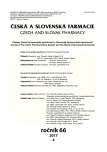Synergistic effect of azole antimycotics (clotrimazole and fluconazole) and natural substances
Authors:
Martin Kuruc; Eva Čonková
Published in:
Čes. slov. Farm., 2017; 66, 164-167
Category:
Original Articles
Overview
Nowadays the treatment of fungal infections is difficult due to increasing resistance of fungal pathogens to antimycotics. The efficacy of antimycotics can be increased by a proper combination of commercial drugs and natural substances. The 100% antimycotic activity was found using susceptibility testing of Candida albicans yeasts on clotrimazole alone and in combination with tea tree oil, or with a multicomponent preparation containing cannabis oil and various essential oils and in combination with propolis tincture. Combination of natural substances with fluconazole seems to be also prospective. Fluconazole alone achieved an antifungal activity of 80.95% but natural active substances increased its efficacy by 9.55–14.25%.
Key words:
Candida albicans • fluconazole • clotrimazole • natural active substances • synergism
Sources
1. Cheng, S. C., et al. Interplay between Candida albicans and the mammalian innate host defense. Infect. Immun. 2012; 80, 1304–1313.
2. Dabas P. S. An approach to etiology, diagnosis and management of different types of candidiasis. J. Yeast Fungal Res. 2013; 4(6), 63–74.
3. Tömölová Z., Zmrhal J. Mykotické vulvovaginitidy v našich ambulancích. Prakt. Gyn. 2005; 9(2), 35–39.
4. Williams D. W., Lewis M. Candida biofilms and oral candidiosis: Treatment and prevention. Periodontol. 2011; 55, 250–265.
5. Buchta V., et al. Současné možnosti léčby kožních a slizničních mykóz. Med. Pro Praxi 2009; 6(3), 155–164.
6. Mlynarčík D. Pestrý svet antimykotík. Prakt. Lekárn. 2013; 3, 20–22.
7. Cleveland A. A., et al. Declining incidence of candidemia and the shifting epidemiology of Candida resistance in two US metropolitan areas, 2008–2013: Results from population-based surveillance:PLoS ONE 10 (3): doi:10.1371/journal.pone.0120452
8. Theill L., et al. Prevalence and antifungal susceptibility of Candida albicans and its related species Candida dubliniensis and Candida africana isolated from vulvovaginal samples in a hospital of Argentina. Rev. Argent. Microbiol. 2016; 48, 43–49.
9. Zore B. G., et al. Terpenoids inhibit Candida albicans growth by affecting membrane integrity and arrest of cell cycle. Phytomedicine 2011; 11(13), 1181–1190.
10. Khan M. S. A., et al. Anti-candidal activity of essential oils alone and in combination with amphotericin B or fluconazole against multi-drug resistant isolates of Candida albicans. Med. Mycol. 2012; 50, 33–42.
11. Stringaro A., et al. Effects of Mentha suaveolens essential oil alone or in combination with other drugs in Candida albicans: Evidence-Based and Alternative Medicine 2014; Article ID 125904, 9 pages. http://dx.doi.org/10.1155/2014/125904
12. CLSI. Clinical and laboratory standards institute / National comitee for clinical laboratory standards: Method for antifungal disk diffusion susceptibility testing of yeasts. Approved Guideline – 2nd edition, Document M44-A2. National Comitee for Clinical Laboratory Standards, Wayne, P. A. Clinical and Laboratory Standards Institute 2009; 29(17), 23.
13. CLSI. Clinical and laboratory standards institute / National comitee for clinical laboratory standards: Reference method for broth dilution susceptibility testing yeasts. Approved Standard – 3rd edition, Document M27-A3. National Comitee for Clinical Laboratory Standards, Wayne, P. A. Clinical and Laboratory Standards Institute 2002; 28(14).
14. Dota K. F. D., et al. A challenge for clinical labolatories: Detection of antifungal resistance in Candida species causing vulvovaginal candidiasis. Lab. Med. 2011; 42(2), 87–93.
15. Elfeky D. S., et al. Species identification and antifungal susceptibility pattern of Candida isolatesin cases of vulvovaginal candidiasis. Alexan. J. Med. 2016; 52, 269–277.
16. Nelson M., et al. Identification and susceptibility profile of vaginal Candida species to antifungal agents among pregnant women attending antenatal clinic of Thika District Hospital, Kenya. Open. J. Med. Microb. 2013; 3(4), 239–247.
17. Martínez M. Heterogenous mechanisms of azole resistance in Candida albicans clinical isolates from an HIV-infected patient on continuous fluconazole tehrapy for oropharyngeal candidosis. J. Antimicrob. Chemother. 2002; 49(3), 515–524.
18. Niimi M., et al. Antifungal drug resistance of oral fungi. Odontology 2010; 98, 15–25.
19. Farrer-Halls G. Aromaterapie od A po Z. 1. vydanie. Praha: Metafora 2007.
20. Mondello F., et al. In vitro and in vivo activity of tea tree oil against azole-susceptible and -resistant human pathogenic yeasts. J. Antimicrob. Chemother. 2003; 51, 1223–1229.
21. Hammer K. A., et al. Antifungal effects of Melaleuca alternifolia (tea tree) oil and its components on Candida albicans, Candida glabrata and Saccharomyces cerevisiae. J. Antimicrob. Chemother. 2004; 53, 1081–1085.
22. Marcos-Arias C., et al. In vitro activities of natural products against oral Candida isolates from denture wearers. BMC Complement. Alter. Med. 2011; 11, 119. http://www.biomedcentral.com/1472-6882/11/119
23. Ramage G., et al. Antifungal, cytotoxic, and immunomodulatory properties of tea tree oil and its 3 derivate components: Potential role in management of oral candidosis in cancer patients. Front Microbiol. 2012; 3, 220. http://journal.frontiersin.org/article/10.3389/fmicb.2012.00220/full
24. Ahmad A., et al. In vitro synergy of eugenol and methyleugenol with fluconazole against clinical Candida isolates. J. Med. Microbiol. 2010; 59, 1178–1184.
25. Abu-Darwish M. S., et al. Essential oil of common sage (Salvia officinalis L.) from Jordan: Assessment of safety in mammalian cells and its antifungal and antiinflammatory potential: Biomed Res. Int. 2013; 538940. doi: 10.1155/2013/538940. Epub 2013 Oct 9.
26. Leite M. C. A., et al. Investigating the antifungal activity and mechanism(s) of geraniol against Candida albicans strains. Med. Mycol. 2014; 53, 275–284.
27. Pinto E., et al. Antifungal activity of the clove essential oil from Syzygium aromaticum on Candida, Aspergillus and dermatophyte species. J. Med. Microbiol. 2009; 58, 1454–1462.
28. Bankova V., et al. Chemical composition of european propolis: expected and unexpected results. Z. Naturforsch. C. 2014; 57(5–6), 530–533.
29. Stepanović S., et al. In vitro antimicrobial activity of propolis and synergism between propolis and antimicrobial drugs. Microbiol. Res. 2003; 158, 353–357.
Labels
Pharmacy Clinical pharmacologyArticle was published in
Czech and Slovak Pharmacy

2017 Issue 4
Most read in this issue
- Possibilities of using sodium hyaluronate in pharmaceutical and medical fields
- Specifics of some calcium salts in intravenous therapy of hypocalcemia and their further use
- Synergistic effect of azole antimycotics (clotrimazole and fluconazole) and natural substances
- Cholinesterase activity assays and their use in the diagnosis of various pathological states including poisoning by neurotoxic agents
